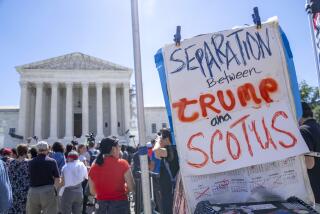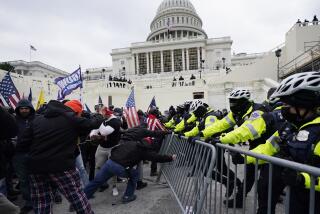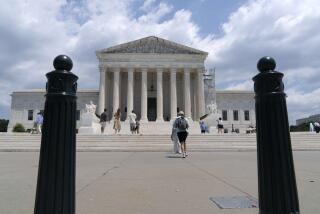Protecting the 1st Amendment, and the president
- Share via
Scenario 1: President George W. Bush delivers a speech and two audience members are removed because they came to the event in a car with an anti-Bush bumper sticker. Scenario 2: The Obama White House organizes a rally to celebrate Democratic victories in the 2010 congressional elections and a “tea party” member wearing a “GOP” T-shirt is excluded.
The first event actually occurred; the second is obviously hypothetical. But that’s not the important difference between the two situations. Nor is the identity of the president.
The crucial distinction is that one is a political rally to which the president and his staff have invited only supporters, as they have the right to do, and the other is a town meeting that was advertised as open to the public. That’s the distinction that a federal appeals court ignored in ruling against Leslie Weise and Alex Young in January and that the U.S. Supreme Court should acknowledge by reviewing the case.
In 2005, Weise and Young obtained tickets for a Bush town hall meeting on Social Security held at an air and space museum in Denver. But they were ordered to leave because a bumper sticker on Weise’s car read “No More Blood for Oil,” a not particularly subtle dig at Bush’s Iraq policy. Weise and Young subsequently sued Michael Casper, who ordered them to leave at the behest of White House aides.
The Denver-based U.S. 10th Circuit Court of Appeals ruled that the suit couldn’t proceed because a 1st Amendment right to attend such functions wasn’t clearly established at the time of the couple’s ejection. The decision was based partly on the theory that the government “can discriminate on the basis of viewpoint.” This implies that the mere presence of a critic at the speech — even one who doesn’t disrupt the event — somehow dilutes the president’s message.
But as dissenting Judge William J. Holloway noted, “the plaintiffs here did not wish to participate in the president’s speech but only to attend it.” Weise and Young were excluded not because they posed any threat of disruption but because of their opinions about the president. Holloway rightly called this “an egregious violation of plaintiffs’ rights.”
The White House is not an open forum, and the president is free to pick and choose those he wants to join him in promulgating or publicizing administration policy. Their presence is an extension of the president’s own speech. But a presidential appearance advertised as open to the public cannot, under the 1st Amendment, discriminate between audience members on the basis of their opinions. That is how the Supreme Court should rule.
More to Read
Get the L.A. Times Politics newsletter
Deeply reported insights into legislation, politics and policy from Sacramento, Washington and beyond. In your inbox three times per week.
You may occasionally receive promotional content from the Los Angeles Times.










